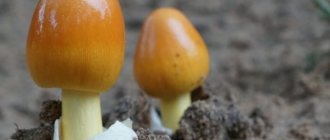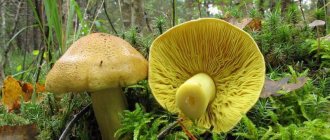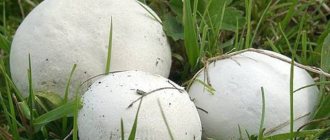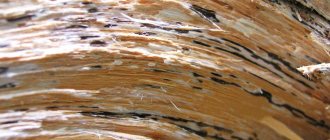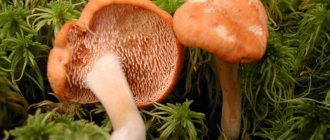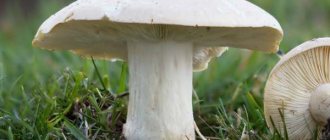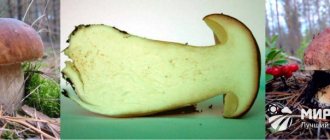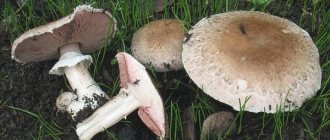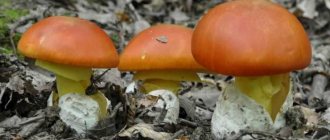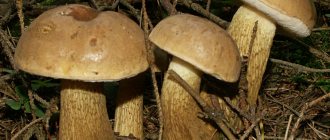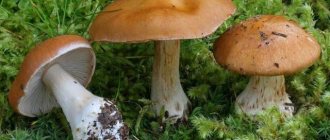Today we’ll talk about the Gall Mushroom, which, due to its bitterness, was never able to gain the approval of lovers of “quiet hunting” and unfairly became a poison. You can learn its history and recipes for proper preparation right now.
Description of the false porcini mushroom
In the CIS, the gall mushroom is often popularly called a false porcini mushroom, since the cap and stem are very similar to this beautiful representative of the forest. However, unlike the latter, it has an extremely unpleasant bitter taste, which is why it got its name. Its Latin name is Tylopilus felleus. The common international nickname is bitter tolopilus. Russian synonyms are mustard, harelip mushroom.
Belongs to the Boletaceae family, the main characteristic of which is the presence of a tubular hymenophore. Rod – tilopil; These mushrooms love to germinate in places where trees are rotting, which is why they have a specific taste.
Sometimes they are poisonous due to the high content of toxins. Many people believe that the taste of mustard does not disappear when cooked, but it cannot be considered dangerous.
Medicinal qualities
From this mushroom, scientists have obtained a number of active substances that are used in medicine. For example, tilopilan is obtained from bittergrass, which is a stimulator of the immune response. Studies conducted in 1994 proved that it has anti-cancer activity. Also, the substances contained in its fruiting bodies help fight the bacterium Propionibacterium acnes, which is the main culprit in the formation of acne (pimples).
In addition to these positive qualities, the pulp contains N-y-glutamyl-bolethin, which has a high antibacterial value.
A little history
It was first discovered by the French scientist Pierre Boulliard back in 1788. Even then, BOLETUS was divided into small genera. Petter Karsten began actively studying the fungus 100 years later and in 1881 he transferred the gall fungus to the genus Tilopilus.
The identification principle was quite simple - a specific germination environment and a tubular hymenophore. Another hundred years later, Friedrich Rostkovius, Lucien Quelet and many others began research.
They could not come to an agreement and every 10 years they assigned this species to different families and genera. As a result, most of the information about the gall fungus was lost.
They returned to it in the 21st century, in 2013. Thanks to high technology and knowledge of genetics, scientists agreed that the mushroom still belongs to Tylopilus, since the species has a number of characteristic mixed characteristics that determine their significance in nature and pharmaceuticals. The mushroom is tubular, therefore it belongs to the genus Tolopilus.
The name fully justifies itself; as 100 years ago, researchers describe it as inedible and undesirable.
Due to the fact that it selects rotten scabs and sprouts mainly on acidic soils, it accumulates bitterness, which sometimes does not disappear even after boiling.
Is this fungus a parasite or not?
He is not a parasite, moreover, he is a kind of forest orderly. It grows only on already fallen trees, absorbing mineral residues. Close plant partners take away nitrogen, which they desperately need in acidic soil.
And also, due to its strong bitterness, the mushroom repels insects that strive to spoil it. Therefore, he rightfully deserves the proud name of a nurse.
hat
It sometimes reaches 30 cm, but the average size is 15 cm. It comes in different shades, it depends on the place where the fungus grows: it has a nut color - if the mustard settles on a snag, gray-yellow, pale brown and cream, which makes it look like white .
At a young age, the cap has a convex shape, but later becomes flat. During the rainy season it is covered with mucus, in the warm and dry season it is rough and, accordingly, dry. The skin on it does not peel off.
Hymenophore
It is the flesh under the cap that determines the type of mushroom. The hymenophore can be tubular and spongy; in Gorchak it is of the first type. Even a beginner can determine this; just break the cap of the mushroom and inspect it - there is a cluster of small tubes up to 3 cm long.
At a young age, the color of the hymenophore is white, and when the cap reaches 15 cm, it becomes pink. It doesn't fit on the leg. Due to it, it has the ability to reproduce; in adulthood, spores are released from here, which are actively carried by the wind, animals or even humans.
Pulp on the cut
The pulp is white and feels dry. It tends to turn red with age and often does not change color when cut. It has no odor and is not affected by insects and worms.
Leg
In a young mushroom it barely reaches 4 cm, grows to an average of 12 cm, its maximum thickness is 2 cm. It has a characteristic cylindrical shape, tapering towards the cap. Feels fibrous, creamy in color. A distinctive feature is a bright brown mesh that peels off easily. Sometimes during the ripening period small pink dust particles (spore powder) may remain on it.
general characteristics
In English-language sources, this weed is often found under the name “Russian knapweed”. Indeed, in appearance, creeping bitterweed, a photo of which can be seen below, is very similar to certain types of cornflowers. Typically the plant reaches a height of up to 75 cm. Its branched stems with numerous oblong leaves are crowned with dark pink flower baskets that bloom in July and bloom until August.
Creeping bitterling is a fairly unpretentious plant. It loves warmth and light, and is very resistant to drought. Its roots can grow to a depth of more than 10 meters and feed on moisture that is not available to other plants. In addition, this weed perfectly tolerates soil compaction and the accumulation of harmful salts in it: carbonates, chlorides, sulfates. The only thing that bitterling does not like is flooding the soil, so it does not grow in rice fields.
Precautions for collection
Many people note that the bitter substances of tolopilus transfer to their hands. Therefore, it is better to assemble and clean it with high-quality gloves. You should not place them with other already collected mushrooms of a different family; the bitter taste is easily absorbed by them.
Collecting in heavily contaminated soils (garbage, chemicals) is not recommended; the mushroom tends to absorb toxins, purifying the nature around it. Consumption of such a mushroom is fraught with poisoning.
It also accumulates radioactive isotopes, which, if ingested in large quantities, can even lead to death.
What makes the fight so difficult?
Gorchak is deservedly considered one of the most difficult to eradicate weeds, since it has the ability to wait out a period of unfavorable conditions in a dormant state. When the soil dries out or the area where bittergrass grows has been plowed, its above-ground parts, as well as the roots located directly underground, die. However, deeper roots retain the ability to live for several years, and when normal conditions return, the plant begins to actively revive.
False doubles
Gorchak, in its color, structure and variability, is very similar to other representatives of tubular mushrooms - porcini mushroom, boletus, honey fungus, milk mushroom, champignon, goat, row, Polish and poisonous satanic. The differences can be seen in the photo.
In order not to confuse it with dangerous or beneficial twin mushrooms, you need to know a few simple rules and features. The main thing: boletus mushrooms, porcini mushrooms, and honey mushrooms have scales on their stems, while the gall mushroom has a mesh.
The satanic one has a bright small leg (3-4 cm in diameter) of pink color, while the bitter tolopilus has a pale one. In the first, the hymenophore tubes turn blue when squeezed, while in the gall tube they are simply white.
How to distinguish from porcini mushroom?
White mushroom
The main difference from boletus: Tylopilus fellows has a strong mushroom smell and a very bitter taste.
But it is undesirable to try, so you can determine it in another way. The first mushroom has a characteristic feature - often when cut, the body begins to darken, acquiring a pink tint. And it also has small scales on its stem, and the gallbladder has a small mesh.
At a young age, the cap of the bitterling has the peculiarity of bending, like that of the white one. But if you wet it, mucus begins to form on it, but the boletus does not have it.
The color of the cap also has its own characteristics: in the gall cap, it barely differs from the general shade of the entire body, often has a little yellowness, and in the white cap, the legs are 90% darker.
Differences between bitterling and boletus
the Gall boletus
from the boletus - it rarely appears in areas of deciduous plants, moreover, it chooses dark and damp places. However, sometimes amazing things happen in nature; spores can be transported to any place in various ways (even by the collector himself), so the appearance of bitterling is not excluded among deciduous trees.
The main difference can be seen already on the stem: while the boletus has its own personal “credit card” in the form of a “birch” pattern, the boletus has just a small pale mesh. You should also pay attention to the thickening of the stem: in the obabka it is straight, smooth and has a gray tint, while in the bitterling it is cone-shaped (with thickening towards the root). The first one has a smooth cap, while the second one has a velvety surface.
How to fight on your own?
From the above, it is clear that it is extremely difficult to resist this weed alone. What should a person do if he finds this ill-fated plant in his garden? The fight against creeping bitterweed in a summer cottage includes a number of measures that should be carried out in combination. Single instances must be removed manually, including its underground parts. If thickets of bitterling are found, they must be completely mowed before flowering begins. Before preparing the soil for sowing, it must be thoroughly plowed, cutting off the roots of the plant as deeply as possible. It is recommended to do the same in late autumn. If the site has not yet been developed, it is better to do the procedure several times. The cut sections of the roots must be selected and destroyed. However, it is quite possible that these measures will not be enough and soon the bitterweed will again begin to attack the area.
It's all about the repeatedly mentioned root system, which allows the weed to revive even after 3-4 years. To completely defeat creeping bitterweed, it is additionally recommended to use chemicals - the herbicides Roundup and Hurricane. It is best to apply them on a warm and dry, but cloudy autumn evening, when the entire harvest has already been harvested. The application method is quite simple and boils down to spraying the stems with a solution of the drug. It is described in more detail in the instructions for the specific herbicide. It is likely that chemical treatment will have to be repeated several times to completely destroy the harmful plant.
In conclusion, let us remind you that bitterling is a quarantine weed, and if it is detected, you must inform the local branch of Rosselkhoznadzor! For failure to comply with this requirement established by law, you can receive a fine - this applies to both legal entities and ordinary citizens!
Edible or not?
Many lovers believe that the mushroom is extremely dangerous and should not be eaten, but this is not true. Of course, if improperly prepared or consumed raw, it will cause slight poisoning. But you can get rid of the toxic bitter taste with simple vinegar.
In France, to remove the bitterness, chefs boil the gall mushroom in milk and then grind it. Its main advantage is its bright and rich smell. In China, bittersweet is even sold as a natural seasoning.
REFERENCE! In the United States, the mushroom is actively grown to treat cancer. Due to the large amount of tilopilan, it has an antibacterial effect.
Is it worth cooking bittersweet?
It’s worth preparing gall mushroom; it can diversify a forester’s diet and provide a lot of pleasant taste sensations. However, you should still not overeat; in most cases, this will cause a laxative effect.
Tolopilus is best used dry and ground, as is done in China, to enhance the flavor of the dish. The taste of the mushroom, if you remove its bitterness, resembles a light fruity sweetness.
It depends to a large extent on the place of germination. If the mushroom is collected under a pear or peach, then, naturally, the taste will be wonderful.
It contains a large amount of healthy carbohydrates and amino acids that will help in the fight against cancer. Research has revealed its anti-carcinogenic properties, so it is especially recommended for use by urban residents.
Cooking precautions
In general, the mushroom is not dangerous, but you should not cook it with other relatives or without processing it. In a pan of food, you can ruin all the food even with one small bitter taste. The taste will be reminiscent of improperly cut fish whose gall bladder has been ripped open.
It is not recommended to cook it; it is very difficult to wash the dishes afterwards. You can follow the example of the French and get rid of bitterness by boiling it in milk. Then the product can be safely used as an addition to soup.
Pickling
You can remove tolopilus from its specific taste by marinating in vinegar. Garlic, onion and bay leaf are also added. After a few days of this treatment, not a trace of bitterness will remain.
The mushroom has a dense structure, so its beneficial properties do not disappear, and it can be a worthy replacement for boring honey mushrooms.
In Mexico, it is pickled in pepper and actively sold in bazaars, but this “double” effect can lead to severe poisoning in an unprepared body.
Regular soaking will also help improve the taste and avoid poisoning. The gall is cut crosswise into two parts and placed in a bath of warm water. The mushroom should be soaked for 2–3 days, changing the water periodically.
After this, you can safely pickle it and pickle it for the winter; there will be no bitterness or indigestion. You can eat it alone or with your favorite dishes.
To increase the shelf life of the collected mushroom, you need to wrap it in paper and place it in the refrigerator.
All species of the genus Tilopil:
| Red porphyrosporus (Tylopilus porphyrosporus) | Gall mushroom (Tylopilus felleus) |
Red-spore fungus (Tylopilus porphyrosporus)Gall fungus (Tylopilus Felleus)
TOP
If you doubt the edibility of the mushrooms you find, do not take them. The site administration does not bear any responsibility for the actions of people taken on the basis of information received on the site. Some types of poisonous mushrooms cannot be identified without special equipment and can be confused with edible ones. For all questions related to the operation of the site, please contact the administration mailbox Copyright ©2016 - 2022
Poisoning and treatment
The main danger of tolopilus is bitterness. Smokers should eat it carefully, as the sensitivity of their taste buds may be reduced. After pickling, the bitterness should completely disappear, but if this does not happen, the mushroom should be disposed of.
If it enters the body in large quantities, it can cause not only poisoning, but in some cases, cirrhosis of the liver.
There is a cumulative effect and symptoms may appear even 3 weeks after consumption. Eating mushrooms in large quantities is not recommended.
Symptoms indicating intoxication and first aid
The only help in case of poisoning is to call a specialist and be sure to tell about the product you consumed. Only a procedure for completely removing toxins from the body will help. Symptoms are difficulty concentrating, weakness, vomiting with the release of bile.

